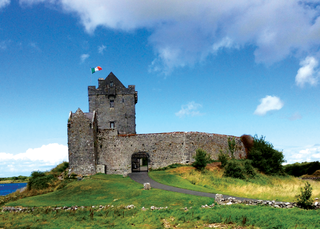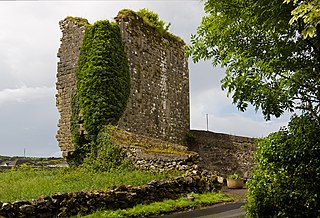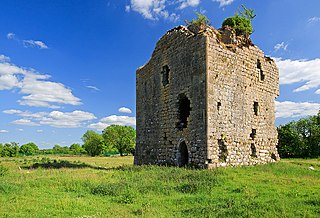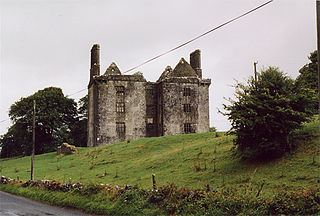
Oughterard is a small town on the banks of the Owenriff River close to the western shore of Lough Corrib in Connemara, County Galway, Ireland. The population of the town in 2022 was 1,846. It is located about 26 km (16 mi) northwest of Galway on the N59 road. Oughterard is the chief angling centre on Lough Corrib.

Straffan is a village in County Kildare, Ireland, situated on the banks of the River Liffey, 25 km upstream of the Irish capital Dublin. As of the 2016 census, the village had a population of 853, a nearly two-fold increase since the 2006 census.

Dunguaire Castle is a 16th-century tower house on the southeastern shore of Galway Bay in County Galway, Ireland, near Kinvara. The name derives from the Dun (fort) of King Guaire, the legendary king of Connacht.

Durhamstown Castle is a 600-year-old towerhouse in the townland of Durhamstown of the civil parish of Ardbraccan which is in the barony (Ireland) of Lower Navan, in County Meath, Ireland. It is named after a Mr Doream and has been converted into a guest house and restaurant.
Eyrecourt Castle was an Irish 17th century country house in Galway which became a ruin in the 20th century. The house, the surrounding estate, and the nearby small town of Eyrecourt all took their name from Colonel the Right Hon. John Eyre, an Englishman who was granted a large parcel of land in recognition of his part in the military campaign in Galway during the Cromwellian conquest of Ireland. There was an earlier fortified house or castle on the same land.

Rolestown,, is a small village six miles (10 km) north-west of Swords along the R125 in Fingal, Ireland. It lies about halfway between Swords and Ashbourne. It is located around two parallel roads intersected by a road that crosses the Broadmeadow River by an old cut stone bridge. Rolestown is also a parish in the Fingal North deanery of the Roman Catholic Archdiocese of Dublin.

Castlegar is a village and electoral division in County Galway, just outside the city of Galway, in Ireland. Castlegar is also an ecclesiastical parish in the Roman Catholic Diocese of Galway, Kilmacduagh and Kilfenora. It extends from Lough Corrib across to Merlin Park by the old Galway-Dublin road.

Ballymore Castle in Lawrencetown, County Galway, Ireland was originally a 15th-century tower house belonging to O'Madden. A house was added in 1620, and the castle has been much altered since then.

The Turoe stone is a granite stone decorated in a Celtic style located in the village of Bullaun, County Galway, Ireland, 6 km north of Loughrea off the R350 regional road. It probably dates to about the period 100 BC to 100 AD. The stone is positioned in a covered protective structure on the lawn in front of Turoe House, set in a concrete base surrounded by a metal cattle grill. The Turoe stone is National Monument of Ireland Nr. 327 (NM#327)

Corofin or Corrofin is a village and parish in County Galway, Ireland, situated on the N17 road between Galway City and Tuam.

Gregans Castle is the name applied to both a 15th-century tower house and a Georgian-style house in the Burren region of County Clare, Ireland, near the village of Ballyvaughan. The latter dates from 1750 and is associated with the Martyn and O'Lochlainn families. The tower house is across the road from the modern house, which is now a hotel.

Glinsk is a small village in County Galway, Ireland, between Creggs and Ballymoe. Glinsk is located approximately 68 km from Galway city and approximately 30 km from Roscommon. It is located in valley of the River Suck, which has a 60-mile hiking trail. Nearby is the Glinsk Castle ruin, built by Ulick Burke in the early 17th century. Also in the area is the ruins of Ballynakill Abbey, which dates from the early 13th century. See Burke Baronets.

Fiddaun Castle is a tower house in Tubber, County Galway, close to the border of County Clare in Ireland. It is a National Monument of Ireland.

Killeen Castle is a 15th-century tower house in Killeen townland, near Castlegar, County Galway, on the western coast of Ireland.

Donamon Castle, or more correctly, Dunamon Castle is one of the oldest inhabited buildings in Ireland and stands on raised ground overlooking the River Suck in County Roscommon. There was a fort here from early times, but the first recorded reference to "Dún Iomghain" is in the Annals of the Four Masters for the year 1154.
Duniry is a townland, with a small village centre, between Tynagh and Abbey, in County Galway, Ireland. Nearby is the townland of Limehill, the south of which has a bog.

Humewood Castle is a 32,668 square feet (3,035.0 m2) Gothic-fantasy mansion built in 1870 in 427 acres of parkland at Kiltegan, County Wicklow in the Republic of Ireland. The mansion was originally built as a private residence of the Hume family. It is currently owned by American billionaire John C. Malone.

Menlo Castle or Menlough Castle, also called Blake's Castle, is a 16th century castle situated on the bank of the River Corrib near Menlo village in County Galway, Ireland.




















